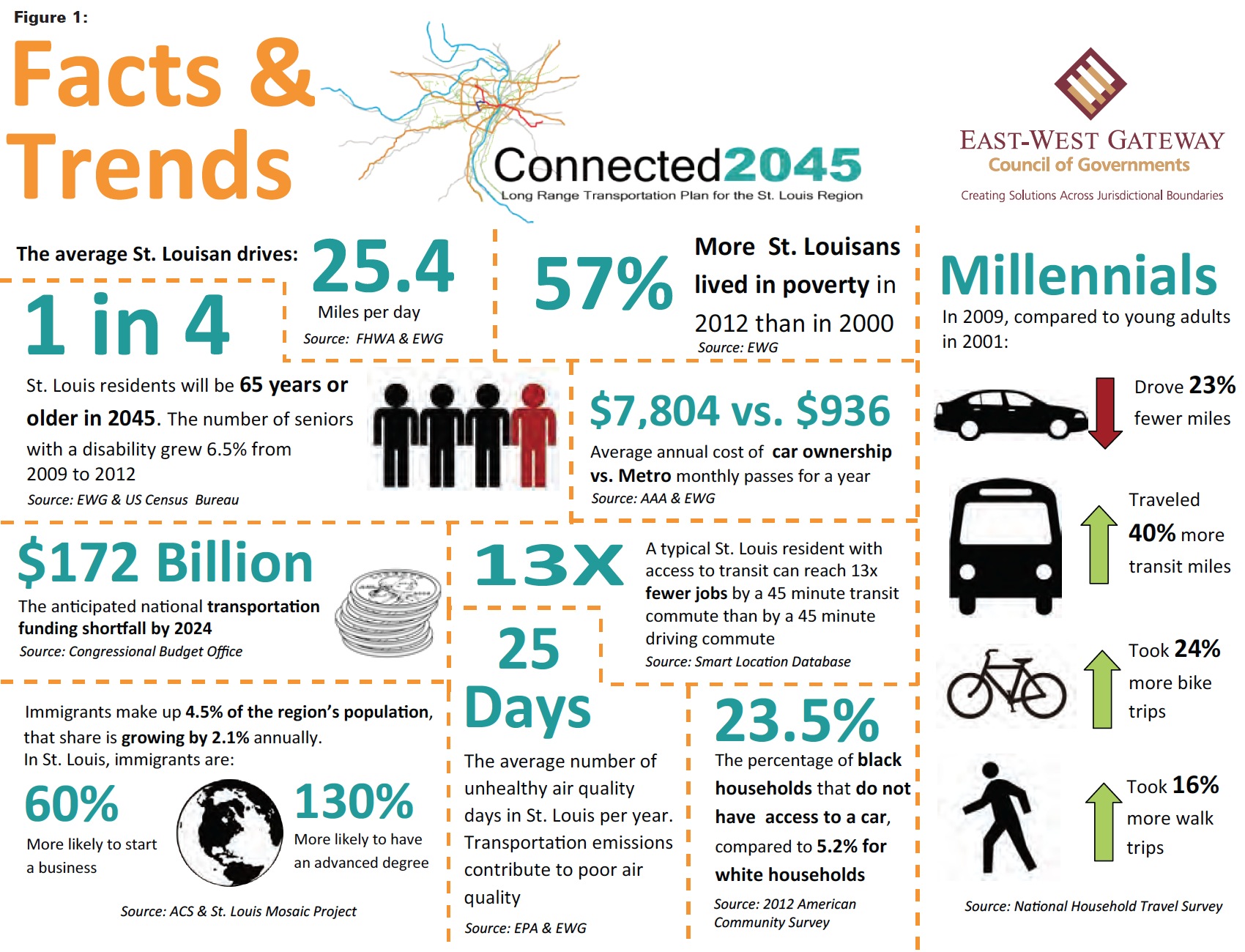EAST-WEST GATEWAY COUNCIL OF GOVERNMENTS
Chapter 1: Regional Context
Connected2045 is the long-range transportation plan for the St. Louis region. Based on input from regional citizens, stakeholders, and guidance from elected officials, it guides transportation decision-making in the region over the next 30 years.
East-West Gateway Council of Governments (EWG) is the St. Louis region’s federally designated Metropolitan Planning Organization (MPO), and, as required by federal law, EWG develops the long-range transportation plan (RTP) every four years. Connected2045 (the Plan) establishes a project and policy-based framework that will be implemented through a variety of short-range transportation plans and programs. While the project list included in Connected2045 focuses on regionally-significant roadway and bridge projects, the policies established by the Plan will guide EWG as it prioritizes funding for all modes of transportation—including public transportation, freight, bicycle, pedestrian and paratransit.
The EWG Board of Directors oversees the development of short- and long-range transportation plans for the region and selects the federally-funded capital projects and operation initiatives that will best carry out the framework created by Connected2045. Project selection is conducted through the Transportation Improvement Program, an annually-updated, four-year list of projects using federal funds. All federally-funded transportation projects must be consistent with Connected2045’s framework to be included in the Transportation Improvement Program (TIP).
Summary and Top Priorities
Connected2045 employed an innovative and well-attended public engagement program to develop a vision for St. Louis’ future transportation system. In an effort to generate excitement about the Plan and reach stakeholders and the public early in the process, EWG partnered with the Missouri History Museum in conjunction with STL250, the 250th anniversary of the founding of St. Louis, to host a four-part regional discussion regarding major transportation issues in the region. At each event, regional leaders addressed the opportunities and challenges the St. Louis region faces as it plans for the future and citizens were given the opportunity to join the discussion and express their opinions via keypad polling. Chapter 1 of the Plan discusses what EWG learned at each of the four speaker series events, and outlines the region’s current transportation context and vision for the future.
The information and feedback received during the speaker series was supplemented by input received from Connected2045’s technical stakeholder group, consisting of regional experts representing many diverse perspectives, from freight and economic development practitioners, to senior citizens, and bicyclists. This group met for a series of workshops that focused on Connected2045’s performance management framework, outlined in Chapter 2, which will guide EWG as it implements the requirements of the current federal transportation law, Moving Ahead for Progress in the Twenty-First Century (MAP-21). With the help of the technical stakeholder group, EWG developed the framework to ensure the region’s transportation investments align with federal and state priorities. The framework also establishes a set of performance measures that will allow EWG to score transportation projects and annually track progress toward achieving the region’s goals.
The feedback received from the public and stakeholders shaped Connected2045 during every phase of its development. The primary message EWG heard from stakeholders and the public was that the region needs to prioritize its limited transportation resources in projects that preserve and maintain its existing infrastructure.
Additionally, with regards to system expansion, there was a strong desire to invest in transportation projects that provide an alternative to single-occupancy automobile travel, primarily transit. Chapter 3 includes Connected2045’s Transportation Investment Plan. It outlines the major projects that will be funded over the next 30 years. Given limited financial resources, this list cannot address the entirety of the region’s transportation needs.
Chapter 4 of Connected2045 summarizes the Plan’s Air Quality Conformity process to ensure that the plan is consistent with regional and state efforts to improve air quality and protect public health.
The State of the System appendix supplements Connected2045. It explores the data and analysis that went into developing the Plan in more detail.
Download full version (PDF): Connected 2045
About the East-West Gateway Council of Governments
www.ewgateway.org
The East-West Gateway Council of Governments (EWG or Council) provides a forum for local governments of the bi-state St. Louis area to work together to solve problems that cross jurisdictional boundaries. The geographic region that
East-West Gateway has served since 1965 is the 4,500 square miles encompassed by the City of St. Louis; Franklin, Jefferson, St. Charles, and St. Louis counties in Missouri; Madison, Monroe, and St. Clair counties in Illinois.
Tags: East-West Gateway Council of Governments, Missouri, MO, St. Louis







 RSS Feed
RSS Feed